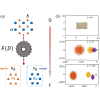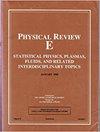Engineering ratchet-based particle separation via extended shortcuts to isothermality
IF 2.4
3区 物理与天体物理
Q1 Mathematics
引用次数: 0
Abstract
Microscopic particle separation plays a vital role in various scientific and industrial domains. Conventional separation methods relying on external forces or physical barriers inherently exhibit limitations in terms of efficiency, selectivity, and adaptability across diverse particle types. To overcome these limitations, researchers are constantly exploring new separation approaches, among which ratchet-based separation is a noteworthy method. However, in contrast to the extensive numerical studies and experimental investigations on ratchet separation, its theoretical exploration appears weak, particularly lacking in the analysis of energy consumption involved in the separation processes. The latter is of significant importance for achieving energetically efficient separation. In this paper, we propose a nonequilibrium thermodynamic approach, extending the concept of shortcuts to isothermality, to realize controllable separation of overdamped Brownian particles with low energy cost. By utilizing a designed ratchet potential with temporal period , we find in the slow-driving regime that the average particle velocity , indicating that particles with different diffusion coefficients can be guided to move in distinct directions with a preset . It is revealed that an inevitable portion of the energy cost in separation depends on the driving dynamics of the ratchet, with an achievable lower bound . Here, is the thermodynamic length of the driving loop in the parametric space. With a sawtooth potential, we numerically test the theoretical findings and illustrate the optimal separation protocol associated with . Finally, for practical considerations, we compare our approach with the conventional ratchets in terms of separation velocity and energy consumption. The scalability of the current framework for separating various particles in two-dimensional space is also demonstrated. This paper bridges the gap between thermodynamic process control and particle separation, paving the way for further thermodynamic optimization in ratchet-based particle separation.

通过扩展等温捷径实现基于棘轮的粒子分离工程
微观粒子分离在各种科学和工业领域发挥着至关重要的作用。传统的分离方法依赖于外力或物理屏障,在效率、选择性和对不同颗粒类型的适应性等方面存在固有的局限性。为了克服这些局限性,研究人员不断探索新的分离方法,其中基于棘轮的分离方法值得关注。然而,与棘轮分离的大量数值研究和实验调查相比,其理论探索显得薄弱,尤其缺乏对分离过程中能量消耗的分析。后者对于实现高能效分离具有重要意义。在本文中,我们提出了一种非平衡热力学方法,将捷径的概念扩展到等温性,从而以较低的能量成本实现过阻尼布朗粒子的可控分离。通过利用设计的具有时间周期τ的棘轮势,我们发现在慢速驱动状态下,粒子的平均速度v¯s∝(1-D/D*)τ-1,这表明具有不同扩散系数D的粒子可以在预设D*的引导下向不同的方向运动。研究表明,分离过程中不可避免的一部分能量成本取决于棘轮的驱动动力学,可实现的下限为 Wex(min)∝L2|v¯s|。这里,L 是参数空间中驱动环的热力学长度。利用锯齿势,我们对理论结论进行了数值检验,并说明了与 Wex(min) 相关的最佳分离协议。最后,出于实际考虑,我们将我们的方法与传统的棘轮方法在分离速度和能耗方面进行了比较。我们还展示了当前框架在二维空间中分离各种粒子的可扩展性。本文填补了热力学过程控制与颗粒分离之间的空白,为基于棘轮的颗粒分离中的进一步热力学优化铺平了道路。
本文章由计算机程序翻译,如有差异,请以英文原文为准。
求助全文
约1分钟内获得全文
求助全文
来源期刊

Physical review. E
物理-物理:流体与等离子体
CiteScore
4.60
自引率
16.70%
发文量
0
审稿时长
3.3 months
期刊介绍:
Physical Review E (PRE), broad and interdisciplinary in scope, focuses on collective phenomena of many-body systems, with statistical physics and nonlinear dynamics as the central themes of the journal. Physical Review E publishes recent developments in biological and soft matter physics including granular materials, colloids, complex fluids, liquid crystals, and polymers. The journal covers fluid dynamics and plasma physics and includes sections on computational and interdisciplinary physics, for example, complex networks.
 求助内容:
求助内容: 应助结果提醒方式:
应助结果提醒方式:


